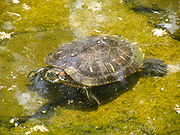
Los Tres Ojos
Encyclopedia
Los Tres Ojos is the name given to a 50-foot open-air limestone
cave
located in the Mirador del Este park, in the Santo Domingo Este
municipality of the Dominican Republic
. A series of three lakes, or ojos, the site is currently one of the most visited tourist attractions in the country. The caves are open from 9 am to 5 pm, and are illuminated at night by a myriad of colored lights.
Indians
who were the first inhabitants of the Hispaniola island. The three lakes are called "Aguas Azufradas" (discovered in 1916), "The Nevera" and "El Lago de las Mujeres". Some of the lakes also have openings on the outside. A staircase cut into the rock gives access to the first cave. A boat pulls visitors across the second lake.
 The caves are fed by water from an underground river and surrounded by stalactites and stalagmites. The composition of the water varies. The two ponds are respectively made of sulphurous water and salt water, while the large lake is composed of freshwater
The caves are fed by water from an underground river and surrounded by stalactites and stalagmites. The composition of the water varies. The two ponds are respectively made of sulphurous water and salt water, while the large lake is composed of freshwater
. Their temperature varies between 20°C to 29°C, depending the upon the site, and their various depths give rise to different coloured reflections, blue, green, and sometimes yellow. The fauna is also very varied and includes fish
, bat
s and turtles. Surrounding vegetation is lush and abundant. The depth of the lake remains unknown. The lakes formed a backdrop to some scenes from the movie Jurassic Park
.
Limestone
Limestone is a sedimentary rock composed largely of the minerals calcite and aragonite, which are different crystal forms of calcium carbonate . Many limestones are composed from skeletal fragments of marine organisms such as coral or foraminifera....
cave
Cave
A cave or cavern is a natural underground space large enough for a human to enter. The term applies to natural cavities some part of which is in total darkness. The word cave also includes smaller spaces like rock shelters, sea caves, and grottos.Speleology is the science of exploration and study...
located in the Mirador del Este park, in the Santo Domingo Este
Santo Domingo Este
Santo Domingo Este is a municipality and the provincial capital of the Santo Domingo province in the Dominican Republic. Within the municipality there is one municipal district : San Luis.....
municipality of the Dominican Republic
Dominican Republic
The Dominican Republic is a nation on the island of La Hispaniola, part of the Greater Antilles archipelago in the Caribbean region. The western third of the island is occupied by the nation of Haiti, making Hispaniola one of two Caribbean islands that are shared by two countries...
. A series of three lakes, or ojos, the site is currently one of the most visited tourist attractions in the country. The caves are open from 9 am to 5 pm, and are illuminated at night by a myriad of colored lights.
History
The site was created centuries ago as a result of tectonic fractures when underground caves collapsed, forming a bowl-shaped depression which subsequently filled with water. Initially, the cave was inhabited by the indigenous TaínoTaíno people
The Taínos were pre-Columbian inhabitants of the Bahamas, Greater Antilles, and the northern Lesser Antilles. It is thought that the seafaring Taínos are relatives of the Arawak people of South America...
Indians
Indigenous peoples of the Americas
The indigenous peoples of the Americas are the pre-Columbian inhabitants of North and South America, their descendants and other ethnic groups who are identified with those peoples. Indigenous peoples are known in Canada as Aboriginal peoples, and in the United States as Native Americans...
who were the first inhabitants of the Hispaniola island. The three lakes are called "Aguas Azufradas" (discovered in 1916), "The Nevera" and "El Lago de las Mujeres". Some of the lakes also have openings on the outside. A staircase cut into the rock gives access to the first cave. A boat pulls visitors across the second lake.
Description

Freshwater
Fresh water is naturally occurring water on the Earth's surface in ice sheets, ice caps, glaciers, bogs, ponds, lakes, rivers and streams, and underground as groundwater in aquifers and underground streams. Fresh water is generally characterized by having low concentrations of dissolved salts and...
. Their temperature varies between 20°C to 29°C, depending the upon the site, and their various depths give rise to different coloured reflections, blue, green, and sometimes yellow. The fauna is also very varied and includes fish
Fish
Fish are a paraphyletic group of organisms that consist of all gill-bearing aquatic vertebrate animals that lack limbs with digits. Included in this definition are the living hagfish, lampreys, and cartilaginous and bony fish, as well as various extinct related groups...
, bat
Bat
Bats are mammals of the order Chiroptera "hand" and pteron "wing") whose forelimbs form webbed wings, making them the only mammals naturally capable of true and sustained flight. By contrast, other mammals said to fly, such as flying squirrels, gliding possums, and colugos, glide rather than fly,...
s and turtles. Surrounding vegetation is lush and abundant. The depth of the lake remains unknown. The lakes formed a backdrop to some scenes from the movie Jurassic Park
Jurassic Park
Jurassic Park is a 1990 science fiction novel written by Michael Crichton. Often considered a cautionary tale on unconsidered biological tinkering in the same spirit as Mary Shelley's Frankenstein, it uses the mathematical concept of chaos theory and its philosophical implications to explain the...
.
External Links
- Los Tres Ojos travel guide

